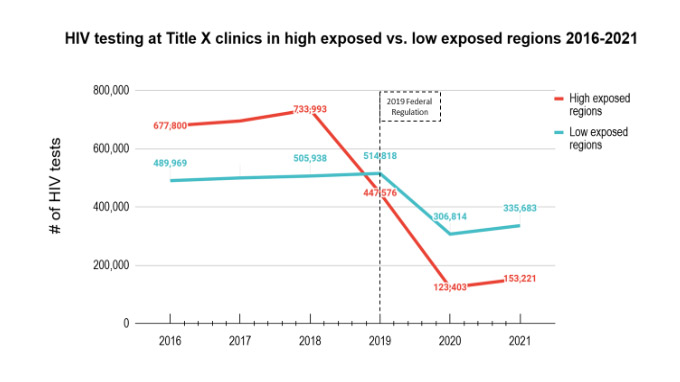Title X Restrictions Harm the U.S. HIV Response
New amfAR study shows that progress in ending the HIV epidemic is jeopardized when federal limits are placed on family planning services
Amid escalating political attacks on reproductive and sexual health services in the U.S., Title X family planning funding is once again under threat. The current administration has already withheld funding from some grantees, raising alarms that restrictive policies similar to those enacted in 2019 could soon be reinstated. These shifts come at a critical moment for the nation’s HIV response.
New research from amfAR’s Andelson Office of Public Policy shows just how critical U.S. federal support for family planning clinics is—not only for reproductive health, but also for the nation’s HIV response. Title X-supported clinics are commonly the first point of access for HIV testing and referrals, especially for low-income women. When federal support falters, the HIV epidemic worsens.
The consequences of lost support became clear in 2019, when the U.S. government imposed restrictive regulations on clinics funded through the Office of Population Affairs’ Title X Family Planning Program. Title X provides grants to state health departments, non-profit organizations, and community health centers for services such as contraception, sexually transmitted infection (STI) and HIV testing and prevention, cancer screenings, and pregnancy counseling.
The 2019 federal regulations required financial and physical separation between programs funded by Title X and facilities with abortion services. Of note, since the 1976 Hyde Amendment, federal funds have always been prohibited from covering abortion services. Additionally, the 2019 regulation mandated that providers funded by Title X must refer pregnant clients for prenatal care and barred them from referring their clients for abortion services. Many providers could not comply. Between June 2019 and August 2021, 1,280 sites—nearly one-third of the entire Title X network—left the program.

The impact was immediate and devastating: 844,000 fewer clients received family planning services at Title X-funded clinics in 2019 than in 2018. In 2020, with the added strain of the COVID-19 pandemic, 2.4 million fewer family planning clients were served than in 2018. In both cases, analyses found the majority of this decline was attributed to the administration’s policy changes.
Importantly, some states with the highest losses of Title X clinics are also the states with the most women living with HIV. Because Title X clinics serve as safety net clinics—providing services to populations that may struggle to get services at other locations—reduced capacity at Title X clinics could mean more people going without HIV services.
“amfAR study found that the 2019 regulations were responsible for over 69,000 fewer HIV tests conducted at Title X clinics, and a 4% reduction in new HIV diagnoses at Title X clinics while in place.”
For the first time, researchers have documented the impact of this federal regulation on HIV services at Title X clinics. Led by Jennifer Sherwood, PhD, Director of Research, Public Policy, amfAR, the study compared HIV testing and diagnoses at Title X sites in U.S. regions highly impacted by the 2019 federal regulations compared to regions which were less impacted. The study found that the 2019 regulations were responsible for 69,626 fewer HIV tests conducted at Tile X clinics*, and a 4% reduction in new HIV diagnoses** at Title X clinics while in place. These reductions could have major public health implications in the U.S. if these HIV cases went undiagnosed, especially for vulnerable populations who rely on Title X services.
The figure below shows the number of HIV tests performed at Title X clinics in regions that were highly exposed and less exposed to the 2019 regulations.

The stakes are high. Between 2016 and 2021, the Title X program was responsible for diagnosing between 4% and 10% of all HIV cases nationwide. Its role is indispensable to the U.S. effort to end the HIV epidemic. Undermining this program risks reversing hard-won progress against HIV and deepening existing health inequities.
“Without policies that promote HIV testing and diagnoses, the U.S. will struggle to eliminate HIV as a public health threat by 2030,” says Jennifer Sherwood. “When the Biden Administration reversed these policies, clinics began to rejoin the Title X program, but interruptions in federal support of these services threaten to derail the sustained HIV response necessary to end the HIV epidemic.”
Read the full analysis currently available in pre-print by clicking here.
*(95% CI -108,893 to -30,359; P<.001)
**(95% CI -7% to -0%; P=.05)
Share This:
